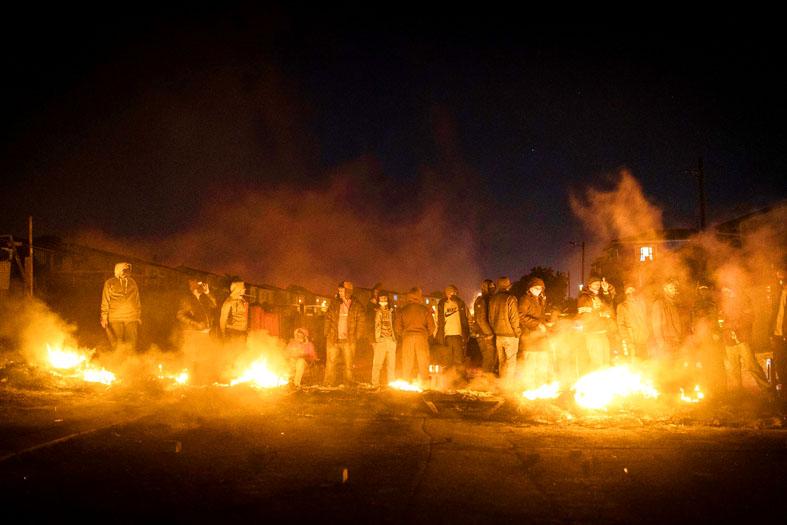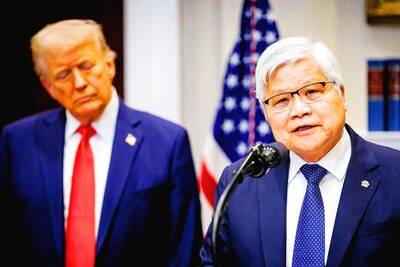South Africa’s death toll from days of riots on Thursday rose to 117 even as the worst of the violence appeared to ease, with the deployment of thousands of soldiers starting to take effect.
Authorities have arrested almost 1,500 people, including 12 who allegedly instigated the unrest, resulting in rampant looting and the destruction of businesses in two key provinces, South African Acting Minister in the Presidency Khumbudzo Ntshavheni told reporters in Pretoria.
The situation remains volatile in KwaZulu-Natal province, the heart of the violence, while the economic hub of Gauteng should stabilize soon, she said.

Photo: AFP
About 10,000 troops are now on the streets, leading to a drop in the number of incidents.
“These are not demonstrations, this is economic sabotage,” Ntshavheni said.
Protests erupted on Saturday last week after former South African president Jacob Zuma was imprisoned for defying a court order, before spiraling out of control as marauding mobs began to loot stores, banks and medical facilities.
The rising death count represents the most lethal uprising since the buildup to the end of apartheid in 1994, when violent demonstrations and subsequent crackdowns were relatively commonplace.
Telecommunications towers and other infrastructure have been destroyed, while transport networks and a program to vaccinate people against COVID-19 have been disrupted.
Business Leadership South Africa, one of the country’s main business lobby groups, estimates that damages amount to more than 5 billion rand (US$343 million) for the retail industry alone.
More than 200 shopping malls were targeted, more than 800 stores were looted, and 100 were completely burnt, the group’s chief executive officer, Busi Mavuso, told Bloomberg via e-mail.
Attention is now turning to whether insurance companies will be able to cover the cost of the carnage, with claims estimated to run up to several billions of rand.
The sheer number of affected businesses means that it is likely that processing claims would be slow and an interim fund might have to be set up for support, said Martin Kingston, an official at Business Unity South Africa, another industry group, which is calling for a rolling 24-hour curfew in the key provinces and a full deployment of the South African military to bring an end to the crisis.
“It will take two to three years to recover the infrastructure lost here,” former Goldman Sachs Group Inc. Sub-Saharan Africa chairman Colin Coleman said. “To restock these centers will take 10 weeks, and we are going to have severe shortages for some time.”
Some groups have urged South African President Cyril Ramaphosa to give the police and military additional powers to end the violence, fearing that communities and private militias would mete out their own forms of justice.
Video footage published on Johannesburg-based radio station Kaya 959’s Web site showed private security guards firing live ammunition at a mob on Tuesday.
“I really would like to see our president talking to people, and giving a level of affirmation and confidence,” Investec PLC chief executive officer Fani Titi said. “At this point in time, we need much firmer communication.”

‘CROWN JEWEL’: Washington ‘can delay and deter’ Chinese President Xi Jinping’s plans for Taiwan, but it is ‘a very delicate situation there,’ the secretary of state said US President Donald Trump is opposed to any change to Taiwan’s “status quo” by force or extortion and would maintain that policy, US Secretary of State Marco Rubio told the Hugh Hewitt Show host on Wednesday. The US’ policy is to maintain Taiwan’s “status quo” and to oppose any changes in the situation by force or extortion, Rubio said. Hewitt asked Rubio about the significance of Trump earlier this month speaking with Taiwan Semiconductor Manufacturing Co (台積電) chairman C.C. Wei (魏哲家) at the White House, a meeting that Hewitt described as a “big deal.” Asked whether the meeting was an indication of the

‘RELATIVELY STRONG LANGUAGE’: An expert said the state department has not softened its language on China and was ‘probably a little more Taiwan supportive’ China’s latest drills near Taiwan on Monday were “brazen and irresponsible threats,” a US Department of State spokesperson said on Tuesday, while reiterating Washington’s decades-long support of Taipei. “China cannot credibly claim to be a ‘force for stability in a turbulent world’ while issuing brazen and irresponsible threats toward Taiwan,” the unnamed spokesperson said in an e-mailed response to media queries. Washington’s enduring commitment to Taiwan will continue as it has for 45 years and the US “will continue to support Taiwan in the face of China’s military, economic, informational and diplomatic pressure campaign,” the e-mail said. “Alongside our international partners, we firmly

KAOHSIUNG CEREMONY: The contract chipmaker is planning to build 5 fabs in the southern city to gradually expand its 2-nanometer chip capacity Taiwan Semiconductor Manufacturing Co (TSMC, 台積電), the world’s biggest contract chipmaker, yesterday confirmed that it plans to hold a ceremony on March 31 to unveil a capacity expansion plan for its most advanced 2-nanometer chips in Kaohsiung, demonstrating its commitment to further investment at home. The ceremony is to be hosted by TSMC cochief operating officer Y.P. Chyn (秦永沛). It did not disclose whether Premier Cho Jung-tai (卓榮泰) and high-ranking government officials would attend the ceremony. More details are to be released next week, it said. The chipmaker’s latest move came after its announcement earlier this month of an additional US$100 billion

Authorities yesterday elaborated on the rules governing Employment Gold Cards after a US cardholder was barred from entering Taiwan for six years after working without a permit during a 2023 visit. American YouTuber LeLe Farley was barred after already being approved for an Employment Gold Card, he said in a video published on his channel on Saturday. Farley, who has more than 420,000 subscribers on his YouTube channel, was approved for his Gold Card last month, but was told at a check-in counter at the Los Angeles International Airport that he could not enter Taiwan. That was because he previously participated in two